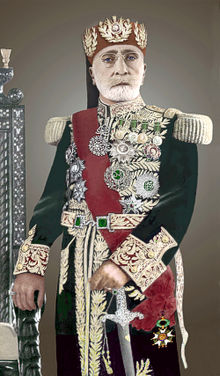| Muhammad VIII al-Amin | |||||
|---|---|---|---|---|---|
| Lamine Bey | |||||
 | |||||
| King of Tunisia | |||||
| Reign | 20 March 1956 – 25 July 1957 | ||||
| Predecessor | Himself as Bey of Tunis | ||||
| Successor | defunct (Habib Bourguiba as President of Tunisia) | ||||
| Bey of Tunis | |||||
| Reign | 15 May 1943 – 20 March 1956 | ||||
| Predecessor | Muhammad VII | ||||
| Successor | Position abolished (Himself as King of Tunisia) | ||||
| Born | September 4, 1881 Carthage, Beylik of Tunis | ||||
| Died | September 30, 1962 (aged 81) Tunis, Tunisia | ||||
| Burial | Cemetery of Sidi Abdulaziz, La Marsa | ||||
| Spouse | |||||
| Issue | Princess Lalla Zakia Princess Lalla Aïcha Princess Lalla Khadija Prince Chedly Bey Princess Lalla Soufia Prince Mohammed Bey Prince Salaheddine Bey Princess Lalla Zeneïkha Zanoukha Princess Lalla Fatma Princess Lalla Kabboura Princess Zakoua Princess Lalla Lilia Princess Lalla Hédia | ||||
| |||||
| Name in Arabic | الأمين باي بن محمد الحبيب | ||||
| Dynasty | Husainid Dynasty | ||||
| Father | Muhammad VI al-Habib | ||||
| Mother | Lalla Fatouma El-Ismaila | ||||
| Religion | Sunni Islam | ||||
Muhammad VIII al-Amin (Arabic: محمد الثامن الأمين; 4 September 1881 – 30 September 1962) commonly known as Lamine Bey (Arabic: الأمين باي), was the last Bey of Tunis (15 May 1943 – 20 March 1956),[1][2] and also the only King of Tunisia (20 March 1956 – 25 July 1957).
He was enthroned in unusual circumstances following the removal of his predecessor Muhammad VII al Munsif by the French Resident General Henri Giraud in 1943. It was not until the latter's death in 1948 that his legitimacy was recognized by the people of Tunisia. He took steps to align himself with the Tunisian national movement against the French protectorate but was sidelined by the Neo Destour after he accepted French-initiated reforms in 1954. Shortly after independence Lamine Bey was turned out of his palace along with his family. Their property was seized and several family members were imprisoned. He ended his days living in a small apartment in Tunis.
- ^ El Mokhtar Bey, De la dynastie husseinite. Le fondateur Hussein Ben Ali. 1705 - 1735 - 1740, éd. Serviced, Tunis, 1993, p. 70
- ^ Ruf (1975), p. 432